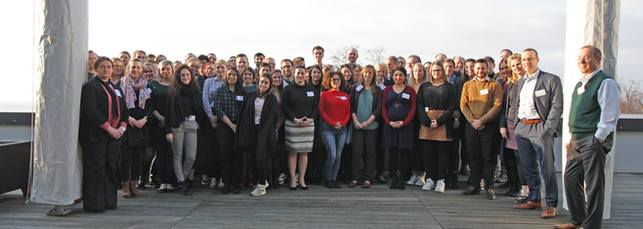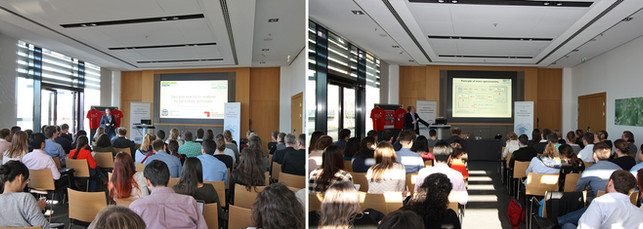
Dr. Heidi Noels and Dr. Yvonne Döring receive the W.H. Hauss Award from the DGAF
19-21 April 2018
Dr. Heidi Noels from the Institute for Molecular Cardiovascular Research at RWTH Aachen University together with Dr. Yvonne Döring from the Institute for Prophylaxis and Epidemiology of Circulatory Diseases at LMU Munich together received the DGAF W.H. Hauss Award 2018 from the German Society for Atherosclerosis Research (DGAF) during the 32nd Annual Meeting of the DGAF in Rauischholzhausen, Germany. They were awarded for their publication "Vascular CXCR4 Limits Atherosclerosis by Maintaining Arterial Integrity: Evidence From Mouse and Human Studies." (Circulation. 2017; 136: 388-403). In this work it could be shown that vascular CXCR4 has an atheroprotective function by maintaining the arterial integrity and preserving the endothelial barrier function. In addition, CXCR4 stabilizes a contractile smooth muscle cell phenotype. Targeted enhancement of these CXCR4-mediated protective functions could open up novel therapeutic options in the treatment of atherosclerosis.
The award was sponsored by a long-standing active member of the DGAF, Prof. Dr. Winfried März.
Project area Z
Administrative project
Robert Werner Mertens
MD student
University Hospital RWTH Aachen
Department of Internal Medicine
Project: The role of incretin hormone GLP-2 in septic cardiomyopathy
PI: Michael Lehrke
Robert Werner Mertens
MD student
University Hospital RWTH Aachen
Department of Internal Medicine
Project: The role of incretin hormone GLP-2 in septic cardiomyopathy
PI: Michael Lehrke
Consortium


Mechanisms of Cardiovascular Complications
in Chronic Kidney Disease
The SFB/TRR219 is supported by the German Research Foundation (DFG)
Project-ID 322900939
Archiving and Data Preservation (#10)
This letter guides users through the essentials of data preservation, from careful planning and choosing compatible formats to maintaining detailed documentation and metadata. It highlights the steps needed to ensure data remains accessible and usable over time, including creating a data management plan, choosing recommended storage formats, and documenting data generation and analysis procedures.

Introduction
The research data you generate is invaluable, and planning ahead to manage it properly during collection, preparation, and analysis is a vital part of the research process. Ensuring your data remains accessible, understandable, and usable long after your project ends is equally important.
Archiving your data at the project’s end preserves a copy for future reuse by yourself or others. Planning and selecting appropriate file formats, documenting your data thoroughly, and finding a trusted repository will help ensure your data is available and usable well beyond the life of your project.
What is archiving?
A data archive involves more than the infrastructure hosting the data; it includes a dedicated team that collaborates with researchers to preserve and curate the data effectively.
Beyond accepting and organizing deposits, a data archive manages access, ensuring the integrity, authenticity, and reliability of the information it holds. Archiving is more than depositing datasets; it involves processes to guarantee:
-
Submitted files can be accessed and are in suitable formats for long-term usability.
-
Adequate documentation is included so data can be understood and reused by others.
-
Datasets have appropriate metadata to be findable and identifiable.
Long-term data preservation
Research data preservation is challenging due to the vast amounts of data generated and the complexity of formats. Digital data requires compatible software to be accessible, and with rapid technological advances, storage media, file formats, hardware, and software may become obsolete. Without proper data management, data is at risk of becoming inaccessible over time.
Steps to preserve your data
-
Create a Data Management Plan (DMP)
A DMP at the project's start helps anticipate data generation, storage, and archiving needs, easing the archiving process later on. For guidance on DMPs, check out our newsletter on data management planning.
-
Store Data Using Recommended Formats
When possible, use non-proprietary formats that don’t require specific software, ensuring your data is future-proofed.
-
Keep Detailed Documentation
Detailed documentation will help you and others understand the data’s structure, processing steps, and methods, making your data usable for years to come.
Documenting your data
Digital data must be machine-readable, but clear documentation is essential for both human understanding and validation of analysis outputs. Documenting your data generation methods, data manipulation steps, and derived measures ensures future usability.
Using Coscine for Enhanced Metadata Documentation
Coscine offers extensive metadata capabilities that allow you to describe your data thoroughly, enhancing its discoverability and reuse. This platform supports detailed metadata fields that document your data generation, processing, and analysis methods, making it easier for others to understand and utilize your dataset.
For Your Benefit
You may be familiar with your dataset now, but over time, remembering the specifics (like what "sglmemgp" means) can be challenging. Good documentation supports your long-term understanding.
For the Benefit of Others
Others may need your data for understanding methods, verifying findings, replicating research, or conducting related studies. Effective documentation enables them to do so with ease.
Conclusion
Effective research data management is a cornerstone of ensuring that the data you work so hard to collect and analyze remains accessible, usable, and meaningful long after your project ends. By planning ahead, documenting thoroughly, and choosing reliable archiving solutions like Coscine, you’re taking important steps to secure the longevity of your work. Good documentation and the use of comprehensive metadata not only serve your own future needs but also support the broader research community. Thoughtful archiving and data preservation mean that your data can continue to contribute to new discoveries, collaboration, and knowledge-sharing for years to come.
Disclaimer
I hope this was an interesting read. If you have comments, remarks, or suggestions about other RDM-related topics for the next newsletters, please let me know by sending me an email at dukkart@itc.rwth-aachen.de.
Image designed by freepik











